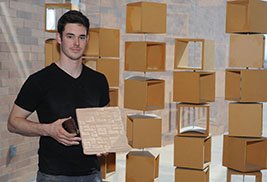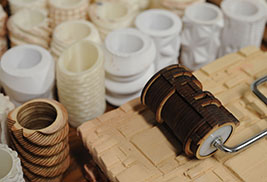Featured Article
Kent State Receives State Funds for Expanded Internship and Co-op Programs
Kent State University was selected to receive $500,000 in state grant funds for expanded co-op and internship programs.
read moreCollege of Architecture and Environmental Design Prints in 3-D
Posted April 28, 2014 | Morgan Jupina
Timothy Soeder, architecture and environmental design
graduate student at Kent State University, displays a tile
designed using a 3-D printer.
Kent State University’s College of Architecture and Environmental Design offers students innovative tools to transform abstract concepts into tangible models with two state-of-the-art 3-D printers.
Mark Meszar, senior IT user support analyst at Kent State, says the Ultimaker Original printer operates by heating plastic from a spool to a melting point and feeding it through a nozzle one layer at a time until it creates the desired 3-D object. The Form1 from Formlabs works by hardening a photosensitive liquid resin with a green wavelength laser.
Meszar says the printers are great for anything that needs rapid prototyping because the cost of printing is fairly cheap. He says the printers are available to graduate and undergraduate students, and printing costs range from about 75 cents to six dollars per piece.
“The printers allow us to visualize a concept and turn it into a tangible model,” says Meszar. “Students are free to do conceptual details because the cost to operate these printers is significantly lower than the machines from five years ago.”
Brian Peters, assistant professor in the College of Architecture and Environmental Design, says 3-D printing is a trial and error process. He says the students first draw a 2-D model of a building by hand then enter the drawing into a computer. Design software generates a digital model of their design then exports the code to the machines to print a small, 3-D building figure.

A roller created from one of Kent State University's 3-D
printers is used to imprint a design on a tile.
“The machines print in detail,” says Peters. “They’re relatively quick and inexpensive, which allows the students to fabricate several iterations of their design so if they don’t like something, they can fix it and reprint.”
Timothy Soeder, architecture and environmental design graduate student, says the 3-D printers have greatly expanded the possibilities of what he can design in the architecture studio.
“3-D printing has allowed me to produce relatively cheap, quick and high quality models,” says Soeder. “I’ve used the printer to produce scale models and components of buildings and even to create one-of-a-kind gifts for family and friends.”
Peters says 3-D printing is becoming increasingly popular in the business world, and it is important for students to be prepared.
“We’re trying to get the students interacting with these printers because it’s the future,” says Peters. “Firms are using them now, and students need to be exposed and prepared for when they graduate.”
Soeder says the printers have a lot of potential success in the architecture field.
“It will provide a new method of fabrication and production never truly seen before,” says Soeder. “As 3-D printers grow much larger, more precise and cheaper, they will expand our manufacturing capabilities.”
Meszar says the College of Architecture and Environmental Design has been collaborating with other disciplines across campus such as art, biology and fashion for other 3-D-printing projects.
To learn more about the College of Architecture and Environmental Design, visit www.kent.edu/CAED.
